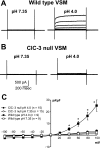The ClC-3 Cl-/H+ antiporter becomes uncoupled at low extracellular pH
- PMID: 19926787
- PMCID: PMC2807314
- DOI: 10.1074/jbc.M109.018002
The ClC-3 Cl-/H+ antiporter becomes uncoupled at low extracellular pH
Abstract
Adenovirus expressing ClC-3 (Ad-ClC-3) induces Cl(-)/H(+) antiport current (I(ClC-3)) in HEK293 cells. The outward rectification and time dependence of I(ClC-3) closely resemble an endogenous HEK293 cell acid-activated Cl(-) current (ICl(acid)) seen at extracellular pH <or= 5.5. ICl(acid) was present in smooth muscle cells from wild-type but not ClC-3 null mice. We therefore sought to determine whether these currents were related. ICl(acid) was larger in cells expressing Ad-ClC-3. Protons shifted the reversal potential (E(rev)) of I(ClC-3) between pH 8.2 and 6.2, but not pH 6.2 and 5.2, suggesting that Cl(-) and H(+) transport become uncoupled at low pH. At pH 4.0 E(rev) was completely Cl(-) dependent (55.8 +/- 2.3 mV/decade). Several findings linked ClC-3 with native ICl(acid); 1) RNA interference directed at ClC-3 message reduced native ICl(acid); 2) removal of the extracellular "fast gate" (E224A) produced large currents that were pH-insensitive; and 3) wild-type I(ClC-3) and ICl(acid) were both inhibited by (2-sulfonatoethyl)methanethiosulfonate (MTSES; 10-500 microm)-induced alkanethiolation at exposed cysteine residues. However, a ClC-3 mutant lacking four extracellular cysteine residues (C103_P130del) was completely resistant to MTSES. C103_P130del currents were still acid-activated, but could be distinguished from wild-type I(ClC-3) and from native ICl(acid) by a much slower response to low pH. Thus, ClC-3 currents are activated by protons and ClC-3 protein may account for native ICl(acid). Low pH uncouples Cl(-)/H(+) transport so that at pH 4.0 ClC-3 behaves as an anion-selective channel. These findings have important implications for the biology of Cl(-)/H(+) antiporters and perhaps for pH regulation in highly acidic intracellular compartments.
Figures










Similar articles
-
Activation of swelling-activated chloride current by tumor necrosis factor-alpha requires ClC-3-dependent endosomal reactive oxygen production.J Biol Chem. 2010 Jul 23;285(30):22864-73. doi: 10.1074/jbc.M109.099838. Epub 2010 May 17. J Biol Chem. 2010. PMID: 20479003 Free PMC article.
-
Overexpression of CLC-3 in HEK293T cells yields novel currents that are pH dependent.Am J Physiol Cell Physiol. 2008 Jan;294(1):C251-62. doi: 10.1152/ajpcell.00338.2007. Epub 2007 Oct 31. Am J Physiol Cell Physiol. 2008. PMID: 17977943
-
Functional analysis of acid-activated Cl⁻ channels: properties and mechanisms of regulation.Biochim Biophys Acta. 2015 Jan;1848(1 Pt A):105-14. doi: 10.1016/j.bbamem.2014.10.008. Biochim Biophys Acta. 2015. PMID: 25306966
-
Coupling gating with ion permeation in ClC channels.Sci STKE. 2003 Jun 24;2003(188):pe23. doi: 10.1126/stke.2003.188.pe23. Sci STKE. 2003. PMID: 12824475 Review.
-
Cell biology and physiology of CLC chloride channels and transporters.Compr Physiol. 2012 Jul;2(3):1701-44. doi: 10.1002/cphy.c110038. Compr Physiol. 2012. PMID: 23723021 Review.
Cited by
-
A critical role for chloride channel-3 (CIC-3) in smooth muscle cell activation and neointima formation.Arterioscler Thromb Vasc Biol. 2011 Feb;31(2):345-51. doi: 10.1161/ATVBAHA.110.217604. Epub 2010 Nov 11. Arterioscler Thromb Vasc Biol. 2011. PMID: 21071705 Free PMC article.
-
Glial Chloride Channels in the Function of the Nervous System Across Species.Adv Exp Med Biol. 2021;1349:195-223. doi: 10.1007/978-981-16-4254-8_10. Adv Exp Med Biol. 2021. PMID: 35138616 Free PMC article.
-
Temperature sensitivity of acid-sensitive outwardly rectifying (ASOR) anion channels in cortical neurons is involved in hypothermic neuroprotection against acidotoxic necrosis.Channels (Austin). 2014;8(3):278-83. doi: 10.4161/chan.27748. Channels (Austin). 2014. PMID: 24476793 Free PMC article.
-
ClC-5 mutations associated with Dent's disease: a major role of the dimer interface.Pflugers Arch. 2012 Feb;463(2):247-56. doi: 10.1007/s00424-011-1052-0. Epub 2011 Nov 15. Pflugers Arch. 2012. PMID: 22083641 Review.
-
Activation of swelling-activated chloride current by tumor necrosis factor-alpha requires ClC-3-dependent endosomal reactive oxygen production.J Biol Chem. 2010 Jul 23;285(30):22864-73. doi: 10.1074/jbc.M109.099838. Epub 2010 May 17. J Biol Chem. 2010. PMID: 20479003 Free PMC article.
References
-
- Jentsch T. J., Poët M., Fuhrmann J. C., Zdebik A. A. (2005) Annu. Rev. Physiol. 67, 779–807 - PubMed
-
- Friedrich T., Breiderhoff T., Jentsch T. J. (1999) J. Biol. Chem. 274, 896–902 - PubMed
-
- Weylandt K. H., Valverde M. A., Nobles M., Raguz S., Amey J. S., Diaz M., Nastrucci C., Higgins C. F., Sardini A. (2001) J. Biol. Chem. 276, 17461–17467 - PubMed
-
- Duan D., Winter C., Cowley S., Hume J. R., Horowitz B. (1997) Nature 390, 417–421 - PubMed
Publication types
MeSH terms
Substances
Grants and funding
LinkOut - more resources
Full Text Sources

